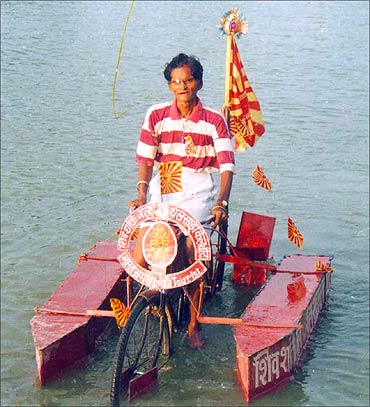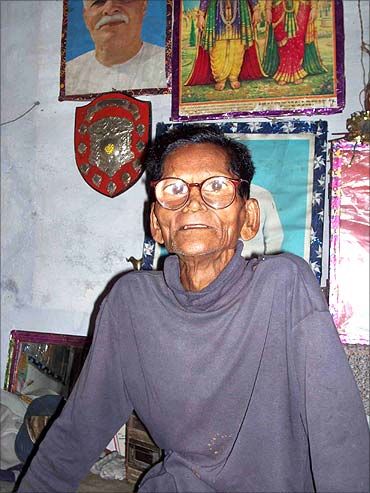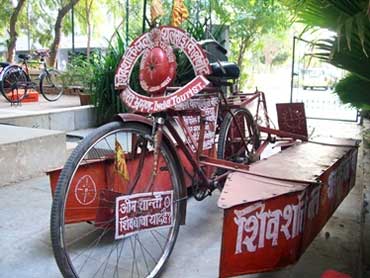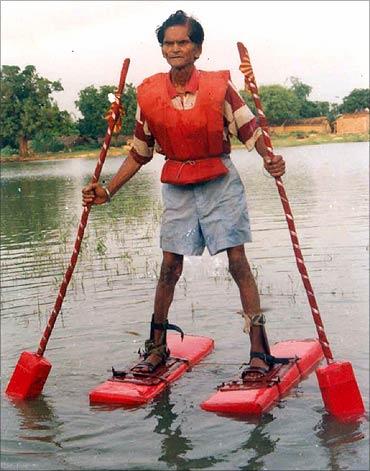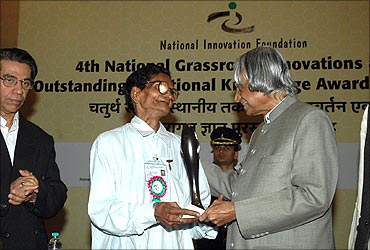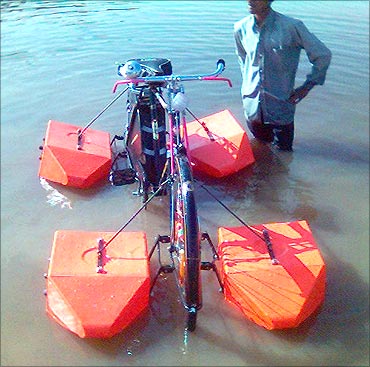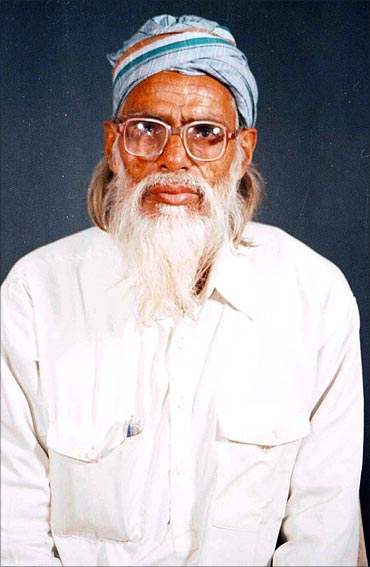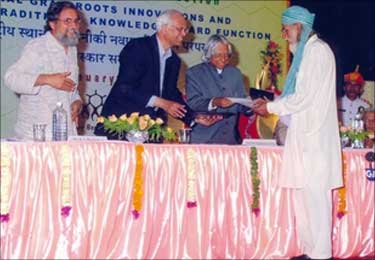 | « Back to article | Print this article |
Amphibious cycles from 2 Indian innovators
You can move on land and water with ease, thanks to these bicycles designed by Dwarka Prasad Chaurasiya and Mohammed Saidullah about three decades back.
While people opted to stay indoors during the floods, Dwaraka and Saidullah changed their bicycles into amphibious vehicles to stay afloat in the raging waters!
Unfortunately, there have been no takers for these low-cost innovations that can be very handy during floods even today. They could also be used in amusement parks or children's parks, for travelling across a flooded river, for removing aquatic weeds, or dragging a raft carrying goods, etc.
After seeing Saidullah's amphibious bicycle, the then President APJ Abdul Kalam remarked that it could be used by defence personnel as well. Saidullah has received the National Innovation Foundation's (NIF) lifetime achievement award for this and many other innovations of his.
He was also selected as one of the 12 finalists for the prestigious Wall Street Journal Asian Innovation Awards. Despite the awards and accolades, both the innovators remain impoverished. Today, Saidullah sells honey to earn his livelihood.
Here's the inspiring story of two versatile innovators. . .
Text and photographs, courtesy: National Innovation Foundation
Amphibious cycles from 2 Indian innovators
After a few small trips of few hundred kilometres in nearby places over a period of three years, Dwaraka Prasad finally left for a long trip to northern India on September 11, 1975.
When he reached Jagadhari in Haryana during the monsoons, the roads were filled with water and his cycle was loaded with his baggage and foodstuffs. He got stranded and it was then that an idea struck him to make an amphibious bicycle.
He bought four empty cans of ghee, took them to a pond around two kilometres away, and tried assembling them to his bicycle in various ways.
Struggling with finances and support, it was only after an intense effort of 2-3 months that he was ready with an amphibious cycle prototype, for testing. Once he became confident, he started showing it to people around; whereever he went people thronged around him in thousands.
Click NEXT to read more...
Amphibious cycles from 2 Indian innovators
He started displaying this amphibious wonder from Mirzapur to Allahabad, from Kanpur and Bitthur to Kanauj to reach Delhi, and then on to Ajmer, Mount Abu, Rajkot, and Porbandar and then to Bet Dwarka (Okha) where he crossed a stretch of five kilometres in high seas. He was taken to a nearby temple and the priests performed an 'aarti' on him.
Buoyed by the success he received, he came to Ahmedabad and demonstrated his cycle at Kankaria Lake in 1980 where tens of thousands witnessed his feat.
The then chief minister of Gujarat gave him an honorarium for his achievement. He then performed in Vadodara and moved to Mumbai for his next performance. In Mumbai, he travelled from Juhu to Nariman Point on the sea and from the Gateway of India to the Elephanta Caves, a stretch of over 11 kilometres in sea, which tested his mental and physical strength.
Click NEXT to read more...
Amphibious cycles from 2 Indian innovators
Dwarka Prasad, also made shoes of thermocol in 1982, which could be used to skate or walk on water. After lot of trials with different shapes and sizes finally, he came up with the first prototype of the water shoes, which were 5 feet long and 4.5 inches wide.
This first attempt was unsuccessful but he was undeterred. After a series of failures, finally he managed to standardize the size to 3 feet in length, 10 inches in width and 8 inches in thickness. This size gave him good buoyancy and ease in maneuvering. Once he had this ready, he went to Delhi to try performing at the Asiad Games but he was not allowed.
He stayed there for a considerable period of time and finally performed at the Delhi Boat Club, which was widely covered by the media. He was also interviewed by BBC during that trip, which was great recognition for him. Since then the shoes have been with him and sometimes he performs on request.
Click NEXT to read on. . .
Amphibious cycles from 2 Indian innovators
Dwarka Prasad uses large specially designed shoes filled with thermocol fitted to each foot and oars filled with thermocol to walk on water. Use of lightweight thermocol gives the desired buoyancy.
The shoes for walking on water consist of two floats made of thermocol, bonded to a rexine sheet. This whole unit is attached to metal straps with back foot support. These two individual shoes are also tied to each other to prevent them from going too far apart beyond one's ability to steer or navigate them.
One needs a pair of hand held oars for balancing while walking in water. Awarded by the then President A P J Abdul Kalam in 2007, Dwarka Prasad dreams of crossing the English Channel one day, despite his old age and precarious economic condition.
Click NEXT to read Mohammed Saidullah's tryst with innovations...
Amphibious cycles from 2 Indian innovators
Saidullah has studied up to the tenth standard in Ramsingh Chatuani in Gajpura but could not complete his studies due to poor financial condition. He married Noor Jahan in 1960 and has three children.
Every innovation of his has been named after his wife, Noor. Thus, we have the 'Noor bicycle', the 'Noor Rahat' electric power house', the 'Noor water pump', etc. Mohd. Saidullah lives with his daughters in Mathia Deah village in Purvi Champaran (Motihari).
Unfortunately his love for innovations has been at a personal cost as Saidullah has sold all of his 40 acres of land in pursuit of his innovations and his generosity. Today, he moves around on his bicycle from place to place and sells honey to earn his livelihood but his passion for innovations remains alive.
Click NEXT to read more...
Amphibious cycles from 2 Indian innovators
Since childhood, Saidullah had an interest in mechanical things. He was always busy solving problems by putting forward innovative solutions in the form of inventions and in one such attempt even broke all the locks in his house.
Initially, he worked as a mechanic because of his interest in making things with iron and this has proved invaluable in his efforts to build the innovations himself. Carpentry, masonry, tailoring, etc., are also part of his repertoire.
Click NEXT to read on . . .
Amphibious cycles from 2 Indian innovators
A philosopher, Mohammed Saidullah's mind is always occupied with problem-solving, which would benefit families and society and he is always in search of innovative ideas. When he gets an idea, his face lights up with a smile.
Impelled by a deep love for nature, which he believes is God's gift to man, he has tried to make his innovations environment-friendly and agriculture-based.
On his innovations, he has worked alone apart from occasional help from his family. Besides the amphibious cycle, he has built the amphibious cycle-rickshaw, spring loaded (shock absorber) bicycle, fodder cutter operated centrifugal pump, key-operated table fan and a mini-tractor.
Click NEXT to read on . . .
Amphibious cycles from 2 Indian innovators
The amphibious bicycle comprises a conventional bicycle modified with two extra attachments that enable it to run on both water and land. The first attachment consists of four rectangular air floats, which support the bicycle while moving on water.
These rectangular floats are in two pairs and each pair is attached to the front and rear wheel of the bicycle with a piece on either side of the wheel. These floats can be folded when the bicycle runs on land. These floats are light in weight and hence the cyclist does not feel any extra burden.
The other attachment comprises the fan blades fixed in a radial manner on the spokes of the rear wheel. When the cyclist pedals the bicycle in water, the blades attached to the rear wheel also rotate and force the water to be pushed backwards thus enabling the bicycle to move forward. The blades are arranged in such a fashion that the cycle can be driven in the reverse direction as well.
Click NEXT to read on . . .
Amphibious cycles from 2 Indian innovators
The advantages are obvious as people in rural areas no longer need to solely depend on the few overcrowded boats for crossing the river. Further, crossing the river can be done at one's own convenience.
As the cycle operates on both land and water, the time and money required for hiring a boat to cross the river and for further transportation on land is saved.
Once Saidullah sent a letter to Jawaharlal Nehru regarding his innovations and invited Panditji to come and see them.
Though Panditji received his letters and replied that he would come, he was not able to and sent a letter to Saidullah regretting his inability to visit his place.
